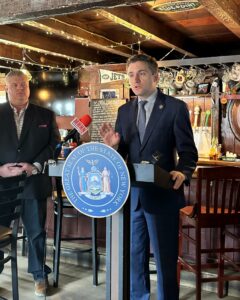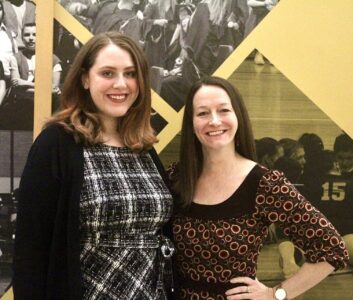Westfield student programs described

Photo by David Prenatt Westfield Academy and Central School science teacher Lon Knappenberger talks to the board of education about his idea of having an Annotate-A-Thon.
WESTFIELD — In December, Westfield Academy and Central School Board of Education members received two special presentations from school faculty and staff regarding distinctive programs that will soon be implemented in the district.
School social worker, DeAnn Shelters, and school psychologist, Ashley Raynor informed the board about the Second Step Program. Also, science and biotechnology teacher, Lon Knappenberger, spoke to board members about the Annotate-A-Thon which he will be holding at the school to raise funds for cancer research.
Raynor and Shelters told board members that the second step program promotes a safe and effective school climate, as well as school success and school connectedness. The program does these things by directly teaching students skills that strengthen their ability to have empathy for others, manage their emotions, and solve problems, they said.
All students in grades K-5 will take part in the program, Shelters said. Although BOCES initially provided support for the program, WACS has taken the initiative to purchase materials, provide training and implement the program on its own, she said.
Shelters and Raynor gave the board a detailed explanation of how the Second Step Program not only teaches skills that improve students’ ability to learn, but enhances empathy, emotion management and problem solving.
“The program promotes development of students’ self-regulation skills, which helps them participate in and benefit from classroom instruction,” Shelters and Raynor said. “The skills for learning are woven into all units.”
By developing students’ self-regulation skills and school connectedness, the Second Step Program prevents antisocial behavior, peer rejection, low academic achievement, impulsive actions and problem behaviors, Raynor and Shelters told the board.
The implementation of the program will take place throughout the rest of the school year, Shelters said. Currently, one teacher from each grade is taking part in the program. In January, a second group of teachers will be trained, followed by a third group in March.
“At the beginning of the 2020-2021 school year, all teachers in grades K-5 will be implementing this program in their classroom in compliance with the NYS Social-Emotional Learning Standards,” Shelters said.,
The presentation by Knappenberger familiarized board members with his work with gene annotation and his plans to conduct an Annotate-A-Thon at the school.
During the Annotate-A-Thon, Knappenberger said, participants will choose from six bacteria genomes. He chose bacteria because they have no “privacy rights” and the genes are small and easy to handle. “Also, they outnumber your body cells by 10 to one, so if you have a billion body cells, you have ten billion bacteria cells,” he said.
Furthermore, Knappenberger said, he believes that bacteria can cause cancer through chronic inflammation of cells. The genomes he chose are not currently being studied. “Nobody is working with them. We would be the only people in the world doing this,” he said.
Knappenberger said you don’t have to be a scientist to annotate a gene; in fact, anyone can do it. Participants will fill in information on existing online forms, he said. “It’s basically a blank Google and you fill in all the blanks,” he said.
“Gene annotation involves putting everything known about the protein in one convenient location.” Knappenberger said. “Gene annotations are not an end in themselves. Annotations guide and inspire wet lab experiments.”
Knappenberger said he first got the idea for this event when he was working with gene annotation at the University of Buffalo. “We were being encouraged to conduct a public lesson, where parents and educators are invited to watch. I thought Gene Annotation would make a great public lesson, because most people don’t know what it is,” he said.
However, Knappenberger said he wanted to do more than just teach the public. “I like the quote ‘a diagnosis of cancer is like being chained to a boulder,'” he said. “I wanted to create an event that people won’t want to miss with a lot of heart and hope,” he said.
Knappenberger said he began to pursue the idea of an event that could help fight a disease. “I have spent so much time doing things for charity that don’t seem to be related to the goals of the charity, like running or walking or rocking in a chair,” he said. “What if the event helped with the goal? What if we conduct original research and raise money for research/treatment at the same time?”
This led to the concept of the Annotate-A-Thon,” Knappenberger said. “The “A” is separate because it is made of DNA in the logo. It reminds one of action, admirable, accomplish, ambition, and altruism.”
Knappenberger was designated a New York State Master Teacher in 2013 and has been nationally recognized for his work in biotechnology. He is a teacher consultant for the NIH (National Institute of Health) and SEPA (Science Education Partnership Award) grants for the Western New York Genetics in Research and Healthcare Partnership.
Knappenberger said he wishes to share his skills in biotechnology in order to help others. “I do this because I feel compelled to do something,” he said. “I have this talent that others don’t. I might as well use it for good.”




